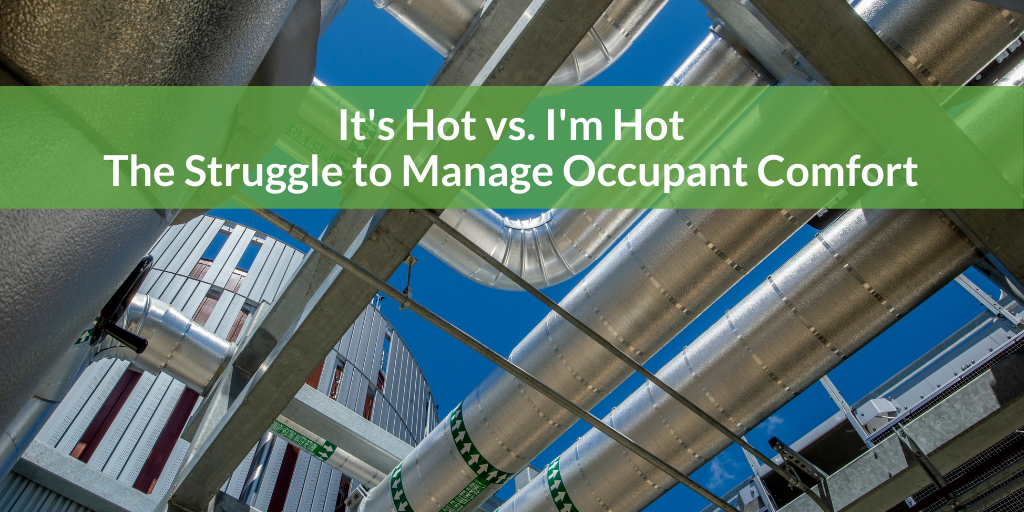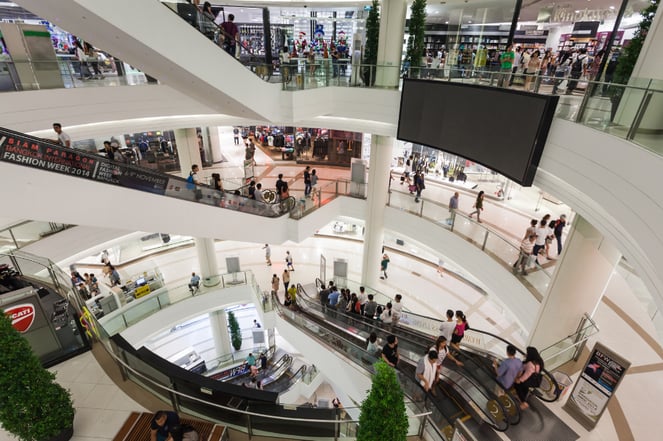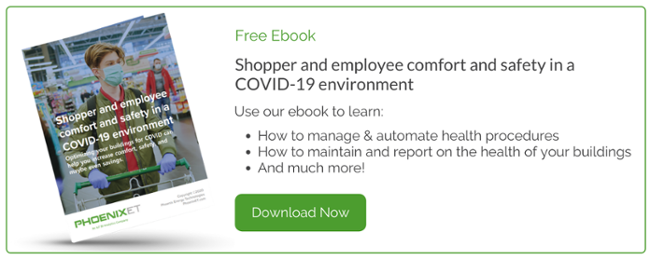Share this
It's Hot vs I'm Hot - The Struggle to Manage Occupant Comfort
by Phoenix Energy Technologies on Nov 30, 2020

Managing occupant comfort levels has always been a tricky science. The pandemic has made this even more challenging, with the addition of required safety masks. Many people feel constricted when wearing a face covering, which complicates airflow and comfortable room temperature perceptions. With this psychological aspect intermingled with the need to adjust settings to increase fresh air circulation, building operators face finding a magic formula that keeps customers happy and safe.
Different energy strategies
One strategy is to start-up air conditioning systems before building occupancy. Chiller and boiler plants need a few hours to cycle and subsequently cool and/or heat spaces, so Building Management Systems (BMS) should schedule them to turn on roughly two hours prior to operation with setpoints from 72-74 degrees, with a 2-degree tolerance depending on the space.
For retail spaces, reducing this setpoint between 70 and 72 degrees may be preferable, as occupants tend to be moving around the store. This strategy will give the building a baseline temperature that can be adjusted slightly to meet comfort levels based on the number of customers entering the building without overtaxing the system.
Or another strategy is to maintain always occupied setpoints, which is a strategy that PetSmart employed at the height of the pandemic (and during scorching summer temperatures) with great success. PetSmart opted to eliminate a 70° overnight setback and put systems on an occupied 73°, rather than lowering temperatures to 71°, which worked really well for them across their 1,600+ locations and did not significantly increase their energy spend. (You can learn more about this in our recorded webinar Balancing Cost and Comfort: The case for always occupied setpoints.)
Balancing Temperature and Air Quality
Once a building becomes occupied, maintaining comfort levels while adjusting for air quality to mitigate recycled air becomes a concern. BMS systems have to increase the air turnover rates in enclosed spaces, meaning your system will need to run longer. But this works in tandem with the need for additional outside air. CO2 monitors can measure the amount of CO2 being produced in a building from occupants, giving an indication of how people are breathing air in a space.
Maintaining shopper and employee comfort & safety in a COVID-19 world
This information can be used at the BMS to request releasing more outside air. Adjusting CO2 levels down allows more fresh air into the space to improve air quality. The unit will then need to operate to condition this air, whether it is a chilled water system or direct expansion, to cool the unconditioned outside air to the desired temperature. During warmer months, this requires the unit to call for cooling to lower the temperatures, but as the temperatures begin to drop, outdoor air can be used as an economizer to aid with cooling. Using this semi-passive cooling method can assist with regulating energy consumption.
Individual Space and Automatic Controls
A step further in finding the balance between customer comfort and safety is installing and programming a sophisticated controls system. At a building operations level, setpoints for temperature, humidity, and CO2 can all be maintained at optimal levels, so they never fall out of range but are maintained at levels that are both safe and economical. These controls give building operators a way to maintain energy systems benchmarks while also appeasing occupants at timeframes or in specific spaces requiring temperatures to be adjusted to meet circumstances.
Building Intelligence Just Got Better - Introducing BI 2.0
Individual spaces can also be supplied with controls to adjust the airflow within a specified tolerance. This is useful in retail spaces where office dwellers may have low occupancy and movement than the large retail space where many customers are moving around in face masks and interacting. In this case, a building operator can allow individuals in offices to adjust the office's temperature up several degrees while reducing floor temperatures to meet comfort and allow more fresh air to enter the building.

Finding the right balance between comfort and safety is a new layer that building managers must consider. Using a baseline temperature, you can switch to occupancy mode adjusting setpoints slightly to meet comfort levels. By changing the settings for CO2 readings to read at a lower PPM, the BMS can call systems to provide more fresh outdoor air. On warmer days, cooling can be called in to reach the desired temperature. But as temperatures get lower in the winter months, outdoor air can aid in cooling as well. Finally, providing individual controls in different areas of the building can give occupants control over individual spaces. This control allows floor personnel to move the temperature down for customers that feel stifled in their masks while enabling office workers to adjust temperatures up to their comfort levels.
For more building management tips, including automation tools and a look at healthy building reports for those wanting to maintain compliance records, please see our comprehensive whitepaper Shopper and Employee Comfort & Safety in a COVID-19 Environment.
Additional Resources:
Driving Comfort and Safety Across 1,600 Retail Stores
What Facility Managers Need to Know About Fire Risks Posed by COVID
Energy Benchmarking Trends in Facilities Management
Share this
- Facilities Management (91)
- Energy Management (69)
- Company News (49)
- Smart Buildings (37)
- Retail (36)
- Building Management (24)
- Building Automation Systems (21)
- Sustainability (20)
- Energy Demand Management (19)
- EEI (15)
- Adaptive Energy Management (14)
- Grocery (14)
- demand response (14)
- Artificial Intelligence (12)
- Data Integration and Visibility (10)
- HVAC IQ (9)
- COVID-19 (8)
- Customer Spotlight (8)
- Carbon Management (7)
- Setpoints and Temperatures (7)
- Equipment Maintenance (6)
- Operational Efficiency (6)
- Refrigeration Optimization (6)
- Ask Ron (5)
- Asset Manager (5)
- Finance and Procurement (5)
- IoT and Digital Transformation (5)
- Awards (4)
- Comfort (4)
- Energy & Store Development (4)
- Safety and Compliance (4)
- Demand Charge Management (3)
- Energy Management System (3)
- Lifecycle Asset Management (3)
- Premium Services (3)
- Refrigeration IQ (3)
- Automated Demand Response (2)
- ConnexFM (2)
- Customer Service (2)
- HVAC Vendor Management (2)
- Load Shedding (2)
- Technician View (2)
- AIM Act (1)
- ALD (1)
- Analytics (1)
- Data (1)
- Data Integration and Visualization (1)
- EMS (1)
- Knowledge Center (1)
- OSHA (1)
- asset management (1)
- December 2025 (1)
- November 2025 (1)
- October 2025 (2)
- September 2025 (1)
- August 2025 (3)
- July 2025 (1)
- June 2025 (1)
- May 2025 (2)
- March 2025 (2)
- February 2025 (1)
- January 2025 (2)
- December 2024 (2)
- October 2024 (1)
- September 2024 (1)
- August 2024 (2)
- June 2024 (2)
- April 2024 (2)
- March 2024 (2)
- January 2024 (1)
- December 2023 (1)
- October 2023 (2)
- September 2023 (2)
- August 2023 (2)
- July 2023 (1)
- May 2023 (2)
- April 2023 (2)
- March 2023 (3)
- February 2023 (1)
- January 2023 (1)
- December 2022 (1)
- November 2022 (2)
- October 2022 (2)
- September 2022 (1)
- May 2022 (2)
- April 2022 (1)
- March 2022 (3)
- February 2022 (2)
- January 2022 (4)
- December 2021 (2)
- November 2021 (3)
- October 2021 (1)
- September 2021 (3)
- August 2021 (4)
- July 2021 (1)
- June 2021 (2)
- May 2021 (1)
- January 2021 (2)
- December 2020 (2)
- November 2020 (2)
- October 2020 (3)
- September 2020 (4)
- August 2020 (3)
- July 2020 (2)
- June 2020 (3)
- May 2020 (3)
- April 2020 (5)
- March 2020 (5)
- February 2020 (4)
- January 2020 (4)
- December 2019 (4)
- November 2019 (3)
- October 2019 (4)
- September 2019 (5)
- August 2019 (4)
- July 2019 (4)
- May 2019 (2)
- April 2019 (3)
- February 2019 (1)
- December 2018 (1)
- November 2018 (1)
- October 2018 (3)
- September 2018 (3)
- August 2018 (3)
- July 2018 (3)
- June 2018 (3)
- May 2018 (1)
- June 2015 (1)
- March 2013 (1)
- January 2013 (1)
- December 2011 (1)
- October 2011 (1)
- September 2011 (1)


